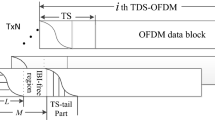Abstract
With the emergence of Wireless multimedia transmission system, the distribution of multimedia contents has now become a reality. To solve the problem of stability in the process of transmission, this paper proposes an improved channel estimation with Bayesian framework based on compressed sensing algorithm in multimedia transmission system. The algorithm uses the sparse characteristics of the channel and can reduce the pilot sequence length under the same conditions. Due to the high complexity of the support agnostic Bayesian matching pursuit algorithm, our algorithm improves the support set, which proposed Expectation Prune Matching Pursuit algorithm in the paper. At each sparsity level of the channel, an expanded support set is given by adding some positions corresponding to the atoms that have a larger inner product value with the current residual signal. Then the best support set is obtained by removing the wrong positions and adopting the idea of Bayesian estimation algorithm in the expanded support set. The estimated channel and the relative probability of the best support set at each sparse level are calculated. Finally, the expectation of the channel is calculated and regarded as the estimation of the channel. Compared with comparison algorithm in the error and bit error rate under different SNR conditions, our proposed algorithm can reduce the computational complexity while maintaining the estimation accuracy.




Similar content being viewed by others
References
Arjav B, PreetidaVinayakray J, Komal G (2018) Performance improvement of wireless multimedia sensor networks using MIMO and compressive sensing[J]. J Commun Info Netw 3(1):84–90
Byun SH, Seong W, Kim SM (2013) Sparse underwater Acoustic Channel parameter estimation using a wideband receiver Array[J]. IEEE J Ocean Eng 38(4):718–729
Chen Z, Hou X, Gong C, Qian X (2016) Compressive sensing reconstruction for compressible signal based on projection replacement. Multimed Tools Appl 75(5):2565–2578
Dai W, Milenkovic O (2009) Subspace pursuit for compressive sensing signal reconstruction [J]. IEEE Trans Inf Theory 55(5):2230–2249
Gao Z, Dai L, Dai W et al (2016) Structured compressive sensing-based Spatio-temporal Joint Channel estimation for FDD massive MIMO [J]. IEEE Trans Commun 64(2):601–617
Gui G, Liu N, Xu L et al (2015) Low-complexity large-scale multiple-input Multiple-Output Channel estimation using affine combination of sparse least mean square filter[J]. IET Commun 9(17):2168–2175
Huang HQ, Su W, Jiang XL An improved compressed sensing reconstruction algorithm used in Sparse Channel estimation[C]// 2016 IEEE international conference on signal processing, communications and computing (ICSPCC). Hong Kong: IEEE 2016:1–4
S Jakubczak, D Katabi (2011) “A cross-layer design for scalable mobile video,” in Proc. 17th Annu. Int Conf Mobile Comput Netw 289–300
D Katabi, H Rahul, S Jakubczak (2009) “Softcast: One video to serve all wireless receivers,” Comput. Sci. Artif. Intell. Lab., Massachusetts Inst. Technol., Cambridge, MA, USA, Tech. Rep. MIT-CSAIL-TR-2009-005
Kivinien, Suvikunniasp, Vuokko, et al. (2002) Experimental Investigations of MIMO Propagation Channels[C]//Proceedings of the 2002 IEEE Antennas and Propagation Society Symposium. Piscataway:IEEE 206–209
Larsson, Edfors, Tufvesson et al (2014) Massive MIMO for next generation wireless systems[J]. IEEE Commun Mag 52(2):186–195
Lv Z, Li Y (2016) A channel state information feedback algorithm for massive MIMO systems [J]. IEEE Commun Lett 20(7):1461–1464
Masood M, AIrNaffouri T (2013) Sparse reconstruction using distribution aGnostic Bayesian matching pursuit [J]. IEEE Trans Signal Process 61(21):5298–5309
Mendez-Rial R, Rusu C, Alkhateeb A, et al. (2015) Channel Estimation and Hybrid Combining for mmWave: Phase Shifters or Switches? [C]// 2015 Information Theory and Applications Workshop (ITA), San Diego CA: IEEE 90–97
Rusu C, Mendez-Rial R, Gonzalez-Prelcic N et al (2015) Adaptive on bit compressive sensing with application to low-precision receivers at mmWave [C]. 2015 IEEE global communications conference (GLOBECOM). IEEE, San Diego, pp 1–6
Shannon CE (2011) A mathematical theory of communication. ACM SIGMOBILE Mobile Comput Commun Rev 5(1):3–55
Shi K, Shi P (2010) Convergence analysis of sparse LMS algorithms with l1-norm penalty based on white input signal. Signal Process 90:3289–3293
Slepian D, Wolf J (1973) Noiseless coding of correlated information sources. IEEE Trans Inf Theory 19(4):471–480
Song X, Peng X, Xu J, Shi G, Wu F (2015) Cloud-based distributed image coding. IEEE Trans Circuits Syst Video Technol 25(12):1926–1940
Su G, Jin J, Gu Y, Wang J (2012) Performance analysis of l0 norm constraint least mean square algorithm. IEEE Trans Signal Process 60(5):2223–2235
Sullivan G, Ohm J, Han W-J, Wiegand T (2012) Overview of the high efficiency video coding (HEVC) standard. IEEE Trans Circuits Syst Video Technol 22(12):1649–1668
Takahashi N, Yamada I (2009) Steady-state mean-sauqre performance analysis of a relaxed set-membership NLMS algorithm by the energy conservation argument. IEEE Trans Signal Process 57(9):3361–3372
Tang Z, Wang S, Huo J, Guo H, Zhao H, Mei Y (2017) Bayesian framework with non-local and low-rank constraint for image reconstruction. In Journal of Physics: Conference Series (Vol. 787, No. 1, p. 012008). IOP Publishing
Wen Y, Zhu X, Rodrigues JJPC, Chen CW (2014) Cloud mobile media: reflections and outlook. IEEE Trans Multimed 16(4):885–902
Wyner A, Ziv J (1976) The rate-distortion function for source coding with side information at the decoder. IEEE Trans Inf Theory 22(1):1–10
Yang L, Xiao S, Xue X, et al. (2017) Fast Sensing Method in Compressive Sensing with Low Complexity[J]. J Xid Univ (01):106–111
Zhang Y, Zhu C, Yap KH (2008) A joint source-channel video coding scheme based on distributed source coding. IEEE Trans Multimed 10(8):1648–1656
Author information
Authors and Affiliations
Corresponding author
Additional information
Publisher’s Note
Springer Nature remains neutral with regard to jurisdictional claims in published maps and institutional affiliations.
Rights and permissions
About this article
Cite this article
Chen, G. Channel estimation with Bayesian framework based on compressed sensing algorithm in multimedia transmission system. Multimed Tools Appl 78, 8813–8825 (2019). https://doi.org/10.1007/s11042-018-6443-1
Received:
Revised:
Accepted:
Published:
Issue Date:
DOI: https://doi.org/10.1007/s11042-018-6443-1




